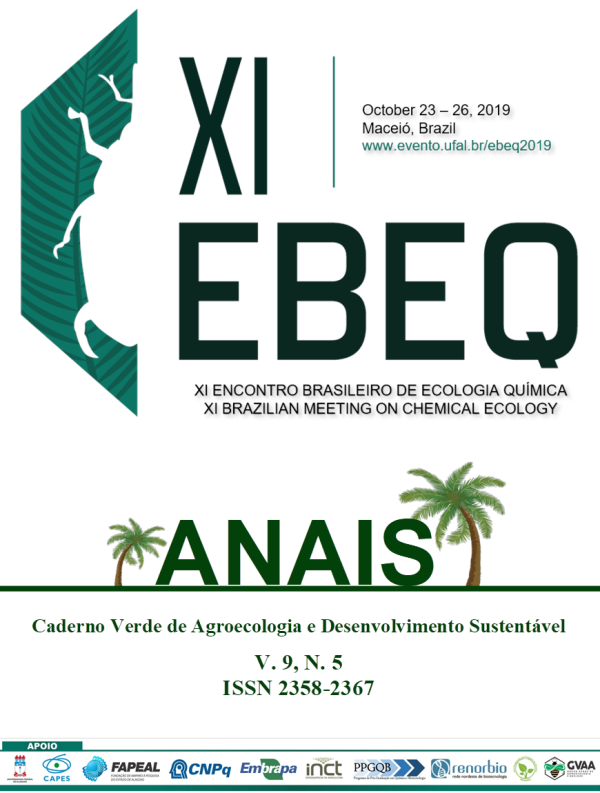LARVICIDAL ACTIVITY of the ESSENTIAL OIL of the LEAVES OF Camará AGAINST Aedes aegypti
Palavras-chave:
ESSENTIAL OIL, Camará, LARVICIDAL, Aedes aegyptiResumo
The Aedes aegypti mosquito is present in several tropical and subtropical climate countries so that, according to the world health organization, about 2.5 billion people are subject to chikungunya, dengue, zika virus and yellow fever. These diseases can lead to death or impair the daily activities of those infected. This vector is present in all Brazilian states and the use of insecticides is one of the ways to combat it. But new strains resistant to the usual insecticides are becoming increasingly common, thus requiring a search for new larvicides. Thus essential oils have been showing promising results in various areas of scientific research. These include the search for insecticides with little or no toxicity, and plants emerge as an alternative to more effective and less toxic formulations. Thus, the objective of this work was to evaluate the use of essential oil of Camará leaves as a larvicidal agent against A.aegypti larvae. The leaves of the biological material were collected in the municipality of Camocim de são Félix / PE. 259g of leaves were shredded and the essential oil extracted by hydrodistillation. To evaluate larvicidal activity, 20 larvae in stage L4 were submitted to different concentrations (645µg / mL, 350µg / mL, 110µg / mL), and mortality was observed at 100, 85 and 35% after 48 hours. This biological activity is due to the presence of germacrene D major compounds, 25.50%; Germacrene D-4-ol, 18.84% and bicyclogermacrene, 11.33% in oil. Therefore, it can be considered that the essential oil analyzed in the tested concentrations was effective in controlling A. aegypti larvae.Referências
ÅSTRÖM, C., ROCKLÖV, J., HALES, S. ET AL. .Potential Distribution of Dengue Fever Under Scenarios of Climate Change and Economic Development. EcoHealth, dezembro 2012, Volume 9, Edição 4 , pp. 448-454
DALARMI, L.; SILVA, C. B. O.; CAMPOS, F. M. M.; BURCI, L. M.; NASCIMENTO, K. A. F.; JESUS, C.; DIAS, J. F. G.; MIGUEL, M. D.; MIGUEL, O. G.; ZANIN, S. M. W. Larvicidal activity of Dalbergia brasiliensis (Fabaceae-Papilionoideae) on Aedes aegypti. Afric. Journ. of Pharm. and Pharm., v. 9, n. 35, p. 881-885, 2015.
DONALD, G.R.; FERNANDES, P.D.; BOYLAN, F. Antinociceptive Activity of Zanthoxylum piperitum DC. Essential Oil. Evidence-Based Complementary and Alternative Medicine, p.1–8, 2016.
HEINZMANN, B. M.; SPITZER, V.; SIMÕES, C. M. Óleos voláteis. In: Farmacognosia: Do Produto Natural ao Medicamento [recurso eletrônico]. Porto Alegre: Artmed, 2017. p. 310–337.
KAMARAJ, C.; BAGAVAN, A.; ELANGO, G.; ABDUZ ZAHIR, A.; RAJAKUMAR, G.; MARIMUTHU, S.; SANTHOSHKUMAR, T.; ABDUL RAHUMAN, A. Larvicidal activity of medicinal plant extracts against Anopheles subpictus and Culex tritaeniorhynchus. Indian J. Med. Res., v. 134, p. 101-106, 2015.
KRAEMER MUG, SINKA ME, DUDA KA, MYLNE A, SHEARER FM, BARKER CM, ET AL. The global distribution of the arbovirus vectors Aedes aegypti and Ae. albopictus. Elife. 2015 jun;4:e08347.
SANTANA, Ht. et al. Essential oils of leaves of Piper species display larvicidal activity against the dengue vector, Aedes aegypti (Diptera: Culicidae). Revista Brasileira de Plantas Medicinais, [s.l.], p.105-111, 2015. FapUNIFESP (SciELO). http://dx.doi.org/10.1590/1983-084x/13_052. Disponível em: <http://www.scielo.br/scielo.php?script=sci_arttext&pid=S1516-05722015000100105>. Acesso em: 23 set. 2019.
SANTOS, Renata P. et al. Chemical composition and larvicidal activity of the essential oils of Cordia leucomalloides and Cordia curassavica from the Northeast of Brazil. Journal Of The Brazilian Chemical Society, [s.l.], v. 17, n. 5, p.1027-1030, out. 2006. FapUNIFESP (SciELO). http://dx.doi.org/10.1590/s0103-50532006000500030. Disponível em: <http://www.scielo.br/scielo.php?script=sci_arttext&pid=S0103-50532006000500030>. Acesso em: 23 set. 2019.
ZARA, A. L. S. A.; DOS SANTOS, S. M. E; OLIVEIRA, S. F.; CARVALHO, R. G.; COELHO, G.E. Estratégias de controle do Aedes aegypti: uma revisão. Epidemiol. Serv. Saúde, Brasília, 25(2):391-404, abr-jun 2016.
Downloads
Publicado
Como Citar
Edição
Seção
Licença
Termo de cessão de direitos autorias
Esta é uma revista de acesso livre, em que, utiliza o termo de cessão seguindo a lei nº 9.610/1998, que altera, atualiza e consolida a legislação sobre direitos autorais no Brasil.
O(s) autor(es) doravante designado(s) CEDENTE, por meio desta, publica a OBRA no Caderno Verde de Agroecologia e Desenvolvimento Sustentável, representada pelo Grupo Verde de Agroecologia e Abelhas (GVAA), estabelecida na Rua Vicente Alves da Silva, 101, Bairro Petrópolis, Cidade de Pombal, Paraíba, Brasil. Caixa Postal 54 CEP 58840-000 doravante designada CESSIONÁRIA, nas condições descritas a seguir:
O CEDENTE declara que é (são) autor(es) e titular(es) da propriedade dos direitos autorais da OBRA submetida.
O CEDENTE declara que a OBRA não infringe direitos autorais e/ou outros direitos de propriedade de terceiros, que a divulgação de imagens (caso as mesmas existam) foi autorizada e que assume integral responsabilidade moral e/ou patrimonial, pelo seu conteúdo, perante terceiros.
O CEDENTE mantêm os direitos autorais e concedem à revista o direito de divulgação da OBRA, com o trabalho simultaneamente licenciado sob a Licença Creative Commons do tipo atribuição CC-BY.
O CEDENTE têm autorização para distribuição não-exclusiva da versão do trabalho publicada nesta revista.
O CEDENTE têm permissão e são estimulados a publicar e distribuir seu trabalho online (ex.: em repositórios institucionais ou na sua página pessoal) a qualquer ponto antes ou durante o processo editorial, já que isso pode gerar alterações produtivas, bem como aumentar o impacto e a citação do trabalho publicado.










